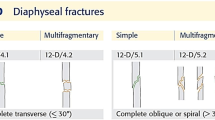Abstract
In the paediatric population, sports, falls and car accidents can result in proximal humerus fractures. Since the proximal humeral growth plate is responsible for up to 80% of the growth of the humerus, remodelling of these fractures in children is enormous: the younger the patient, the higher the potential for remodelling. Most proximal paediatric humeral fractures can be treated successfully by closed means. However, some patient factors or fracture characteristics may prompt for surgical treatment.






Similar content being viewed by others
Bibliografia
Sarwark J, King E, Luhmann S (2008) Estremo prossimale dell’omero, scapola e clavicula. In: Rockwood e Wilkins. Traumatologia pediatrica, 6th edn. Verduci Editore, Roma, pp 707–718
Popkin C, Levine W, Ahmad C (2015) Evaluation and management of pediatric proximal humerus fractures. J Am Acad Orthop Surg 23:77–86
Zember J, Rosenberg Z, Kwong S et al. (2015) Normal skeletal maturation and imaging pitfalls in the pediatric shoulder. RadioGraphics 35(4):1108–1122
De Nicola U, Pannone A (2002) Le fratture prossimali dell’omero nell’adulto e nel bambino. Springer, Milano
Netter F (1999) Atlante di anatomia, fisiopatologia e clinica. In: Apparato muscolo scheletrico, vol. 8. Novartis Edizioni, Varese, pp 40–42
Hutchinson P, Bae D, Waters P (2011) Intramedullary nailing versus percutaneous pin fixation of pediatric proximal humerus fractures: a comparison of complications and early radiographic result. J Pediatr Orthop 31:617–622
Kelly D (2016) Flexible intramedullary mailing of pediatric humeral fractures: indications, techniques, and tips. J Pediatr Orthop 36:S49–S55
Wang X, Shao J, Yang X (2014) Closed/open reduction and titanium elastic nails for severely displaced proximal humeral fractures in children. Int Orthop (SICOT) 38:107–110
Khan A, Athlani L, Rousset M et al. (2014) Functional results of displaced proximal humerus fractures in children treated by elastic stable intramedullary nail. Eur J Orthop Surg Traumatol 24:165–172
Kraus T, Hoermann S, Ploder G et al. (2014) Elastic stable intramedullary nailing versus Kirschner wire pinning: outcome of severely displaced proximal humeral fractures in juvenile patients. J Shoulder Elb Surg 23(10):1462–1467
Goeminne S, Debeer P (2012) The natural evolution of neglected lesser tuberosity fractures in skeletally immature patients. J Shoulder Elb Surg 21(8):e6–e11
Vezeridis PS, Bae DS, Kocher MS et al. (2011) Surgical treatment for avulsion injuries of the humeral lesser tuberosity apophysis in adolescents. J Bone Jt Surg Am 93:1882–1888
Vavken P, Bae DS, Waters PM et al. (2016) Treating subscapularis, and lesser tuberosity avulsion injuries in skeletally immature patients: a systematic review. Arthroscopy 32(5):919–928
Webb L, Mooney J (2009) Fractures and dislocations about the shoulder. In: Green N, Swiontkowski M (eds) Skeletal trauma in children, 4th edn. Saunders, Philadelphia, pp 322–343
Green N, Swiontkowski M (1998) Traumatologia dell’apparato muscolo scheletrico in pediatria. Verduci Editore, Roma
Author information
Authors and Affiliations
Corresponding author
Ethics declarations
Conflitto di interesse
Gli autori G. Bertoni e E. Lelio dichiarano di non avere alcun conflitto di interesse.
Consenso informato e conformità agli standard etici
Tutte le procedure descritte nello studio e che hanno coinvolto esseri umani sono state attuate in conformità alle norme etiche stabilite dalla dichiarazione di Helsinki del 1975 e successive modifiche. Il consenso informato è stato ottenuto da tutti i pazienti inclusi nello studio.
Human and Animal Rights
L’articolo non contiene alcuno studio eseguito su esseri umani e su animali da parte degli autori.
Rights and permissions
About this article
Cite this article
Bertoni, G., Lelio, E. Le fratture dell’omero prossimale in età pediatrica. LO SCALPELLO 32, 228–234 (2018). https://doi.org/10.1007/s11639-018-00295-8
Published:
Issue Date:
DOI: https://doi.org/10.1007/s11639-018-00295-8




